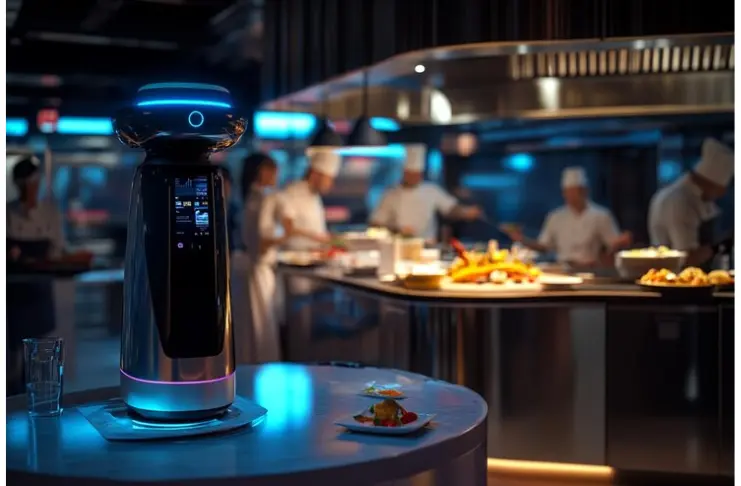
Table of Contents
ToggleThe restaurant industry is rapidly evolving, using advanced technologies to enhance customer experiences and optimize operations. Among these innovations, AI-powered voice assistants are emerging as game-changers. These smart virtual assistants transform how we interact with restaurants, from making reservations to receiving personalized menu suggestions.
According to a recent study, over 40% of consumers already use voice assistants for various tasks, which is expected to grow significantly in the coming years. As voice technology becomes more prevalent, its influence on the restaurant industry is profound, reshaping dining experiences and setting new standards for customer engagement. In this blog, we’ll explore how voice technology transforms the restaurant business, its benefits, and the challenges restaurants might face in integrating these systems.
Understanding Voice Ordering for Restaurants
Voice ordering (or voice commerce) is a user engagement channel that allows customers to place their food orders and restaurants to receive orders using voice recognition technology.
Instead of speaking to a waiter or using a traditional menu, customers can order their meals using voice-activated devices like smartphones, tablets, or smart speakers (e.g., Amazon Alexa or Google Home). This system can understand and process spoken orders, making the dining experience more convenient and efficient.
The Impact of Voice Technology on Restaurant Services
The integration of voice assistants into restaurant services provides unmatched ease and seamless interactions for both customers and businesses. Here are some ways AI voice assistants are impacting the restaurant services:
- Simplified Reservations and Ordering: Customers can effortlessly book a table by simply speaking their desired reservation details using voice assistants. This automated service not only enhances the customer experience but also reduces the workload on restaurant staff, allowing them to focus on delivering exceptional service.
- Personalized Recommendations and Dietary Support: Voice assistants can use customer data to offer personalized menu recommendations that cater to individual tastes and dietary needs. By understanding natural language, these virtual assistants can accommodate complex nutritional restrictions and food allergies, ensuring customers receive suggestions that meet their specific requirements.
- Streamlined Restaurant Operations: AI voice assistants are not just for customer interactions; they also optimize behind-the-scenes operations. From managing inventory and scheduling staff to analyzing recipes, these voice assistants enhance efficiency and reduce costs.
The Role of Voice Technology in Restaurants

- Ordering System: Customers can place orders using voice commands through devices like smart speakers or voice-enabled kiosks. For example, they might say, “Order a cheeseburger and fries,” and the system processes the order. For example, McDonald’s has tested voice ordering at drive-thrus, and Domino’s uses voice assistants to place orders via their app.
- Customer Service Enhancement: Voice technology can answer FAQs, take reservations, and personalize customer interactions by remembering preferences. This leads to quicker service and a more personalized dining experience.
- Backend Efficiency: In the kitchen, voice technology helps staff by allowing them to request supplies verbally, check on orders, and manage inventory without leaving their stations. This reduces errors and speeds up operations.
Benefits of Voice Technology in Restaurants
Here are some of the benefits of integrating voice technology into your operations:
- Speed: Voice technology enhances ordering by allowing customers to place orders quickly through voice commands. This reduces the time spent on manual input and speeds up service. Voice-enabled systems streamline communication between front-of-house staff and the kitchen, which helps in faster order processing and fewer delays.
- Convenience: Customers can place orders without physically interacting with a kiosk or waiting for a server; this helps during busy or high-traffic environments. Voice technology also makes it easier for people with disabilities or those who find traditional interfaces challenging to interact with restaurant systems.
- Accuracy: Voice recognition systems can reduce errors with manual input, like misheard orders. They often include confirmation steps where customers can verify their orders before finalizing them, reducing mistakes and promoting more accurate order fulfillment.
- Cost savings: By automating order-taking and customer interactions, restaurants can reduce the labor cost required at the front line. Moreover, streamlined operations and reduced errors lead to cost savings in inventory management and food waste, as orders are processed more accurately and efficiently.
- Data collection and insights: Voice technology can collect valuable data on customer preferences and behavior, which helps to improve service and personalize marketing strategies. Restaurants can gather insights into order patterns and operational efficiency, helping to optimize workflows and resource allocation.
Challenges and Considerations
While the potential benefits of AI voice assistants in the restaurant industry are undeniable, several challenges and considerations must be addressed:
1. Data Security: Voice-activated systems collect and process customer data, so data security is crucial. Restaurants must protect sensitive information, such as payment details, from potential breaches.
2. Training and Integration: Seamlessly integrating voice technology into existing operations and training staff can be complex. Investing in staff training is essential to maximize the benefits of these systems, which can also help in recruiting, hiring, and retaining employees.
3. Customer Acceptance: Customer acceptance of voice-activated systems varies. While some diners appreciate the convenience and novelty, others may prefer traditional methods. Offering customers a choice and striking a balance is essential.
4. Setup costs: The initial setup cost for AI voice assistants in restaurants is high due to specialized hardware and software, integration with existing systems, and ongoing maintenance. Additionally, staff training and potential disruptions during implementation add to the financial burden. These costs can be particularly challenging for smaller units with limited budgets.
Case Study: Voice Ordering in Restaurants
Domino’s introduced Dom, a chatbot with voice recognition capabilities, in 2014. It enabled customers to place their orders using natural language, enhancing their operations and performance. Since its launch in 2014, Dom has processed over half a million orders, contributing to more than 65% of Domino’s U.S. sales through digital platforms. Some of the benefits of Dom include:

- Voice Recognition Technology: Dom’s ability to understand and process voice commands made the ordering process more intuitive and faster for customers. This technology reduced the need for manual input, minimizing errors and improving order accuracy.
- Order Tracking: In addition to placing orders, Dom helped customers track them in real-time. This feature added a layer of transparency and convenience, enhancing customer satisfaction.
- Operational Efficiency: By automating the order-taking process, Domino’s freed up staff to focus on other critical tasks, especially during peak hours. This led to improved operational efficiency and reduced wait times for customers.
- Customer Experience: Implementing Dom significantly improved the overall customer experience. The ease of placing orders through voice commands and the ability to track orders in real time contributed to higher customer satisfaction and loyalty.
Domino’s innovation with Dom marked a significant milestone in the F&B industry, showing the potential of voice-ordering technology to enhance customer experience and operational efficiency. This move encouraged other fast-food giants like KFC to explore and implement similar technologies. For instance, KFC’s personalized Alexa skills help customers hear menu options, place an order, receive promotional offers, or even hear a chicken joke.
Future Trends and Innovations
Integrating AI voice assistants in the restaurant industry is just the beginning. As technology continues to advance, we can anticipate even more advanced applications and trends:
- Multimodal Interactions: Voice interaction is the primary focus, but future AI assistants will likely integrate multimodal interactions. Combining voice with visual and gesture-based inputs creates a more immersive and intuitive user experience.
- Predictive Analytics and Personalization: With advanced machine learning algorithms and data analytics, AI assistants will become increasingly skilled at predicting customer preferences. This will enable them to offer highly personalized recommendations, improving the dining experience.
- Integration with Smart Home Ecosystems: We can expect seamless integration with smart home ecosystems as AI voice assistants become more common in households. This will allow customers to make reservations and place orders directly from their connected devices. Hence, these innovations are set to transform the restaurant industry, making dining experiences more personalized, efficient, and enjoyable.
Conclusion
Voice technology in the restaurant industry is reshaping how we dine and interact with food services. Its ability to streamline kitchen operations, enhance customer interactions, and improve accessibility is revolutionizing restaurants’ operations. Despite some challenges, the potential for growth and innovation is immense. As more restaurants embrace this technology, they will provide more seamless, personalized, and engaging dining experiences for their customers.








